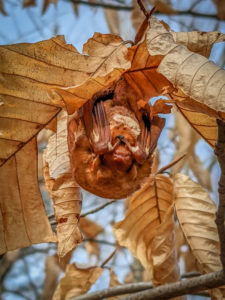Ripples from the Dunes, by Kennedy Zittel, Assistant Naturalist
Woodland Dunes does bat surveys every year to see what bat species are around our preserve and how many of each species we come across. Recently during these surveys, we have discovered that this area has a large population of bats, which is wonderful! This large amount of bats is likely due to the large number of resources located here (and a healthy insect population too!). Bats are great! They are the only flying mammal. They use echolocation to help them see in the dark. And one single bat can eat up to 1,000 insects in an hour. That’s a lot of mosquitoes! Now that it is colder out… what happens to our bats during the winter?
 Bats are classified into two groups depending on how they choose to spend winter. There are the tree bats – those that roost in trees and migrate in the winter. And there are cave bats – those that hibernate in caves and mines during the winter. In Wisconsin, the tree bats are the silver-haired bat, hoary bat, eastern red bat, and evening bat. In Wisconsin, the cave bats are the little brown bat, big brown bat, northern long-eared bat, and the eastern pipistrelle.
Bats are classified into two groups depending on how they choose to spend winter. There are the tree bats – those that roost in trees and migrate in the winter. And there are cave bats – those that hibernate in caves and mines during the winter. In Wisconsin, the tree bats are the silver-haired bat, hoary bat, eastern red bat, and evening bat. In Wisconsin, the cave bats are the little brown bat, big brown bat, northern long-eared bat, and the eastern pipistrelle.
Tree bats commonly roost in trees. These bats will begin to migrate as early as September. They will seek out areas with a warmer climate than where they are leaving from that also have an abundant food source (insects) to help them make it through the winter season. For example, hoary bats, which are some of the most common bats to see here at Woodland Dunes, will travel south and gather in large groups along the US coast and in Northern Mexico.
Cave bats spend winter going through a cycle of torpor followed by periods where they are awake with a raised body temperature (depending on the weather). Torpor involves physiological changes such as changes in body temperature and metabolic rate that allow the animal to survive periods without food. During the winter a bat’s breathing rate, metabolic rate, and heart rate are all reduced. By reducing these rates a bat can reduce its energy costs by 98%! During this time a bat can go minutes without breathing and its body temperature can drop to near freezing. The bat’s heart rate can also drop from 200-300 beats per minute to only 10 beats per minute! How crazy is that? Bats choose places like caves, mines, natural fractures in rocks, and other structures like that due to their constant temperature levels and humidity. The location where a bat hibernates is called a hibernaculum.
One big issue that has been devastating the cave bat populations is a disease called white-nose syndrome. This disease is caused by a fungus (Pseudogymnoascus destructans) that thrives in cool and moist conditions of caves and mines. This fungus infects the living tissues of the bats and causes them to wake up out of torpor too early. By waking them up too early it causes the bats to use up their fat reserves too quickly which starves the bats. Once a cave is infected with the fungus there is a 95% mortality rate of the bats within the cave. Currently, there is no cure for the disease, though scientists are working hard to find a way to stop the disease before it kills off more of the cave bat populations.
We humans often talk about how important our pollinators are and how we need to protect our pollinators, however, it is often forgotten that bats are pollinators too! They pollinate things like bananas, mangos, guavas, cacao, dates, figs, cashews, and peaches. Our nocturnal pollinators are just as important as the daytime ones, and bats need our help. Next time you see a bat, instead of being spooked by it, think about how many mosquitoes that little bat is going to eat in just that night alone, and how bats are cool creatures worthy of our love and support.
